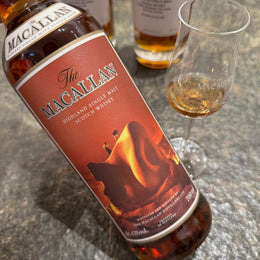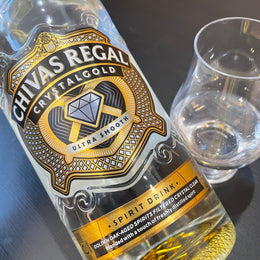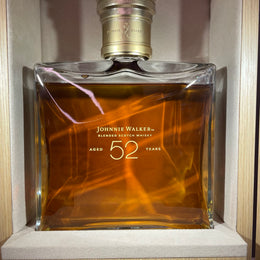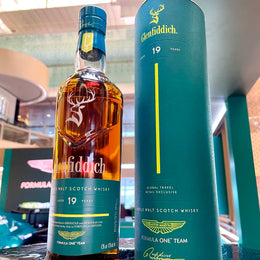Tasting Bunna Through The Years: Bunnahabhain 18 Year Old, 25 Year Old, 30 Year Old, 40 Year Old

Bunnahabhain! The Islay whisky distillery known to do things just a lil' differently compared to their island compatriots: for a region famous for peaty, iodine whiskies, Bunnahabhain goes the other route, producing official bottlings that have a minuscule peat level that is said to be imperceptible.

Source: @bunnahabhain

For a large part of the whisky distillery's history, that wasn't the case! Even today, Bunnahabhain still has a running inventory of peated whiskies, accounting for roughly a fifth of production volume. So, what has gotten Bunnahabhain to steer its helm into non-peated whiskies, at least for their mainline whiskies?
![]()
Taken at the mouth of Margadale River, overlooking Bunnahabhain Bay. The shipwrecked Wyre Majestic can be seen at the centre of the photo. Source: islay.org
Bunnahabhain (pronounced boon-na-ha-ven) was established in 1881. Bunnahabhain is Gaelic for "mouth of the river", and indeed, the distillery sits right at the mouth of the Maragdale River, which water is drawn from to dilute new make spirit.
![]()
The view from if a boat were to dock at Bunnahabhain. Source: islay.org
For a while, Bunnahabhain was touted as the "most remote distillery in Islay", unsurprising as for a large part of the distillery's history, it was only accessible by boat from Port Askaig or Port Ellen, sailing up the Isle of Jura. Even today, only one remote road connects Port Askaig to the distillery, with a town, called Bunnahabhain Village, being built to accommodate distillery workers and staff. The last boat trip that transported supplies to the distillery was made only in 1960!

An aerial view of the distillery. Source: @bunnahabhain
Locals often talk about how Bunnahabhain was build by an architect that specialised in prisons, hence the rather imposing structure and look. But from archives within the University of Glasgow, the reality was much simpler than that: Bunnahabhain was simply modelled after Bordeaux chateaus of the day in terms of layout.
![]()
An old photograph of the distillery. Source: Forbes
Bunnahabhain was founded by a William Robertson of the Robertson & Baxter Group alongside James Watson Greenlees, built in confidence that the whisky industry would continue to boom. Bunnahabhain was, during the time, impressively large and capable of producing large quantities of spirit, aided with state of the art automation.
In 1887, Bunnahabhain, which was owned by the Islay Distillery Company at the time, was eventually sold to Highland Distillers, merging with the William Grant & Co, which then also owned Glenrothes Distillery. The distillery, while exchanging hands relatively few times as compared to many others, did see some bad years: the distillery was briefly shuttered from 1930 to 1937 due to the Great Depression, from 1942 to 1944 due to World War II, and had to operate at a decreased capacity up till 1953 due to grain rationing.
![]()
The number of still doubled from two to four during the 1960s. Source: whisky.com
Bunnahabhain, like the others on Islay, specialised in heavily peated malts, up until the 1960s. While Bunnahabhain was known to be compare to Ardbeg and Laphroaig peat wise, it was soon destined to supply malt to blended whiskies. Shifting towards unpeated whisky, Bunnahabhain's malts were destined to for Famous Grouse (owned by Highland Distillers), Cutty Sark, and Black Bottle (owned by Highland Distillers in 1995). It's also during this time where Bunnahabhain saw massive expansion in its distillery, doubling the stills, phasing out floor malting, and building that road for better logistics.
![]()
The Famous Grouse, the top selling whisky in Scotland, contains malts from Highland Park and Macallan as well. Source: Famous Grouse
It's only during the 1970s where Bunnahabhain began focusing on producing single malts, albeit in small quantities, yet most of it would've been sold to independent bottlers, however. By the 1980s, Bunnahabhain has cemented enough of a following, with an official bottling lineup helmed by the flagship 12 Year Old. For the 1990s, Bunnahabhain made a few dips into its peated roots once more, with most malts meant for independent bottlers. Within this period, the distillery was closed between 1981 and 1983.
![]()
Source: Black Bottle
The winds for Bunnahabhain changed when 2003 rolled over. Highland Distillers was sold to Erdington Group, who then sold the distillery together with the Black Bottle brand to Burn Stewart, a subsidiary of CL Financial. Fate has it that CL Financial would be declared insolvent in 2013, and Bunnahabhain was handed over to Distell, the distillery's long time South African distributor. Despite the exchange of hats, it was during this time that Bunnahabhain underwent a huge rebranding exercise in 2006 for its 12 year old whisky, as well as introducing the 18 year old and 25 year old in the core lineup.
![]()
The folks at malt-review compiled a side-by-side comparison of the Bunnahabhain 12 Year Old, starting from 1979! Source: Malt Review
And with regular limited editions dropped at Fèis Ìle, Islay's biggest whisky festival, a revamped and rennovated distillery and Visitor Centre and a modern facelift to its packaging, Bunnahabhain has cemented itself from a quiet distillery churning malts for blends to a name widely recognised amongst the whisky community.
So, stylistically wise, what makes Bunnahabhain special?
![]()
The stills within the Still Room of Bunnahabhain. Source: alcademics.com
Apart from the non-peated profile (at least, flavour wise), Bunnahabhain is well known for its light, delicate, and sometimes "spicy ginger note" in its whiskies. The lightness of the whisky comes in part from how it's distilled - from using only clear wort (where particles suspended in the liquid is left to settle and hence not in the wort by the time its sent into the still), to having the tallest necks for their stills in Islay. On that note, from 2010, Bunnahabhain has phased out chill filtering of their whiskies.

We've recently celebrated a slice of Fèis Ìle right here in sunny Singapore! We journeyed to Quaichbar Wanderlust, who was hosting a Bunnahabhain festival.

A quick and nifty history guide of Bunnahabhain for the attendees.
And guess what - Andrew Brown, the current Distillery Manager who's been with Bunnahabhain since 1988, was there to join us and lead us in the tasting!

For today's flight, we taste test Bunnahabhain's core range: the 18 Year Old, 25 Year Old, 30 Year Old, and the 40 Year Old. Let's go!

Bunnahabhain 18 Years Old, 46.3% ABV – Review

Nose: Big on dried fruits right from the get go, such as dried apricots, plums, and peaches. Amongst the big dried fruit character, I get some wildflower honey with bee, alongside dried red apple slices. There is some hints of milk chocolate too, with brown sugar and a tinge of ground cinnamon.
Taste: Much denser than expected. You don't get much fresh fruit here, as telling from the nose, but much more dried spices like candied ginger and cardamom spiked caramel brittle, alongside sultanas and raisins. The spice grows quite a bit on the palate, eclipsing the sweeter dried fruit flavours.

Finish: On the finish, it oscillates back and forth between the sweet dried fruit flavours and the spices. In particular, I get the raisins and sultanas again, but moreso the pits and flesh of the fruit. It then gets slightly leathery, like the skin of sausages. The whisky concludes with the dryness of dry white ports, in particular, reminding me of a PX sherry.
My Thoughts
The impressive bit for me was how full bodied and thick the whisky felt on the palate. Despite the strong flavours of dried fruit, it doesn't get cloyingly sweet, but the opposite - there is a dryness to the whisky that is accentuated by the spice. I particularly liked the candied ginger flavour the whisky had start to finish. In short, this dram was pretty enjoyable.
Bunnahabhain 25 Year Old, 46.3% ABV – Review

Nose: I get a strong waft of candied fruits - caramel apples, toffee, caramelised bananas, all while having a background smoky character of toasted marshmallows and burnt ends. There is an ever slight grilled meatiness on the back of the whisky, like a heavily glazed BBQ pork rib.
Taste: On the palate, I get a slight astringent flavour coupled with an intense sweetness, like sweet tea. That sweet-astringent flavour is then paired with caramlised banana, with that dark brown sugar and slightly starchy, sappy texture. On the back, I do get some sweet waxed sausages, as well as a bit of rendered fat from cured meats.

Finish: The waxiness of the whisky reaches its peak here, giving the finish of milk chocolate. There is also that caramelised apple that makes a return, this time intermingling with apple juice. While mild, there is also a slight nuttiness to the whisky here, like crushed peanuts dusted on an ice cream cone. A slight nutmeg flavour lingers on the back palate, and with time, a fennugreek, fennel like flavour radiates of the pangs of the tongue.
My Thoughts
This whisky is fairly dense and sweet, but unlike the 18 year old, shows more confectionery and sugary notes. In particular, there is a heavy waxy texture on the whisky, staying long even at the finish. I'll say that the flavours are a bit punchy with the caramelised fruits at first, but give it subsequent sips, more nuances show, like the spices and that slightly meat savoury quality.
Bunnahabhain 30 Year Old, 46.3% – Review

Nose: Surprisingly bright, with a profound estery note that jumps right at you. I get strong aroma of hard strawberry candy, green apple juice, alongside a hint of melted butter - then when all combined together, gives the impression of apple strudel .The butteriness comes through more as it sits and is given subsequent nosings, reminding me of Weather's original candy and a light dulce de leche.
Taste: Caramel milk candies come to mind first, like butterscotch bites, the same Weather's original, and buttercream. The palate turns to a much more cereal flavour, like semi-sweet granola mixed with pieces of dried berry and coconut. I do get some 3-in-1 coffee as well, in particular, that chocolate-coffee flavour that blends together with creamer.

Finish: The finish develops into a sour berry jam at first: lingonberry, salmonberry, redcurrant jam - that tart quality that comes through the stewed berry flavours. As the tartness fades, I do get some salted caramel bites, bundled with a bit of puff pastry.
My Thoughts
Strong nosing! I really like that strawberry note that jumps right at you, reminding me of a whole myriad of strawberry and cream pastries at once. During the tasting, there is some creamy oiliness throughout, giving the whisky a slight slippery texture. Compared to the previous two, this whisky is perhaps the most approachable, generous with its sweet pastry and confectionery flavours that do reward a satisfying finish.
Bunnahabhain 40 Years Old, 41.9% – Review

Nose: A strong aroma of cacao powder comes at first, which is followed by a mix of vanilla and chocolate aromas: chocolate milkshake, vanilla icing, cookies 'n' creme ice cream. You do get a tinge of fruit at the nosing, but it is very close to heavily cooked apple pie filling or extra sugary orange marmalade. However, let it sit for a while, covered, and it reveals more orange characteristics, like orange soda or orange cordial.
Taste: At first, I got chocolate bonbons, the sort that has brandy or a liqour filling. The whisky then displays a slight sweet-savoury flavour, reminding me of lightly salted nut brittle and caramel peanut butter chocolates. It does get very waxy on the palate, giving a slippery, buttercream texture. On another tasting, the whisky evolves and gives much more spice, like dried sour pineapples, dried kiwi chips, dried slices of ginger, a mild pink peppercorn and some hints of heat from chili.

Finish: On the finish, I initially got the flavour and texture of chocolate cake: the chocolate frosting, spongy and slightly oiled chocolate sponge cake, and that melting shavings of chocolate as topping. The waxiness is ever present, reminding me again of milk chocolate bites. After letting the whisky sit for a while, it then turns to chocolate dipped candied ginger, dried pineapple slices, all the while giving baking spices like cinnamon, cloves and grated nutmeg.
My Thoughts
This whisky is a late bloomer - you need to give it the time of day to develop and evolve. At first, it gives off tons of beautiful chocolate dessert notes, but it continues to evolve as it sits for 10 to 20 minutes. You start to get a whole different flavour profile - spices, dried tropical fruits, and even some tart green fruits.
The full complexity of this whisky is best enjoyed when you give it subsequent sips at regular intervals. I'll even go so far to taste and nose the whisky every 5 minutes and see how it evolves.
Conclusion
The whiskies do give quite a snapshot of the Bunnahabhain house style, and as Distillery Manager Andrew Brown did mention, the 18 Year Old really is the black sheep of the flight. My personal favourite was the 30 Year Old, with how bright and estery the whisky became, giving the whisky a sort of joyful bounce. The 40 Year Old is a close second, for how intriguing its evolution was (during the tasting with Andrew, I was caught off guard at how much it changed, when I took a quick break and returned to the tasting).
Definitely worth a try, especially the latter two. Head over to Quaichbar Wanderlust for a dram!

@vernoncelli







